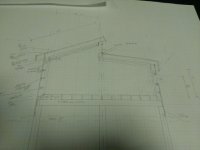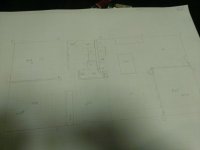so that's why you went missing? you've been busy interning, I love the enthusiasm, I was at the lot today after work, we had some downpours in the morning, holy moly I had standing water in the driveway a good 4 foot higher than the draining ditch, I can't even get to the back without a canoe, yeah I'm not sure about a slab floor,
I love it out there thou, I can't bring myself to leave when I go, we are planning a full day tomorrow, I opened up some drainage ditches hope it starts going down, honestly I am afraid to move the tractor, or it may sink.
there are wetlands nearby, this is relatively higher, but its undisturbed land, the darkest soil I ever saw, and moss and stuff it soaks water like a sponge, I hate to mess with it but I got to, the plan this year is to clear it, and do some grading that is about as far as we may get.


these are couple of my last sketches, I used to do a lot more detail only to realize I need to start over so lately I have been just putting my thoughts on paper, this is after 2 drafting books,
I like pole houses for their minimalistic impact, as I said, I love it out there, I hate to clear it, but I have to at least grade it a bit to get it draining some.
this concept is a bit of a hybrid between the 2, its more compact as a Passivhaus, the angles are all worked out for my area the southside of the house will get direct sunlight on the floor, the northside on the back wall, best I can do for mass is terra tiles, laim compared to Earthships, but if you look into pole buildings there are several ways to frame them, girts and purlins on the outside perimeter, or 2x4 stick build on the inside, I figured both, creating a 12 inch cavity thermal bridge free, works to about R40, 18 inch would be R60-70 gets pretty close to Passivhaus, at that point I would not need as much solar gain or mass since in theory the needs of the building would be a fraction of what is considered normal.
this is a compromise mostly due to my circumstances, the local utility company sells used poles for $1 a foot, I got more lumber on site that I know what to do with, cellulose is cheap etc, plus in Michigan residential under 3500 sqft as long as it is nothing crazy architectural plans are not required and I am aiming for about 1200, the Earthship biotecture plans are 10k, plus I got to find a Michigan licensed architect to sign off, and the health department, it is doable but because of its nature there is significant legwork and expense involved, I could have this roof up before I start pounding tires.
I still want an Earthship, might do a garage/greenhouse at a later date, but I did borrow some concepts, I do plan to collect the water, just not in the plan, what they don't know wont hurt them, I may add a sun room the entire length of the house at a later date, right now I just want to move out there already.
we'll see after I do some digging how it looks, I may change my mind next spring if pull it off this year an get that property draining properly.
my initial thoughts were a massive building, but that is a bitch to waterproof and insulate and you get into high dollar foams, etc,
I got to look up permaculture I come across it all the time I still don't know what it is
oh and this is what I ment by rammed earth, also look up syrewall?? not compressed earth blocks
https://www.google.com/search?q=rammed+earth&tbm=isch&tbo=u&source=univ&sa=X&ei=F2xgU__8EqelsASRtICgBg&sqi=2&ved=0CDIQsAQ&biw=1301&bih=592
as an alternative to tires, by all means I am not against tires, I'm just not too excited about them, but it is pretty hard to duplicate.
this particular lot is too narrow for a Earthship, last I figured it out it would leave me with about 50 feet front yard to the south staring at a wall of trees, its fine now but 20 years later may be shaded, my other lot would work 330 ft east to west 600 due south, and it has a berm too, but that is untampered woods I got a lot of clearing to do there I could be bussy for a while just clearing .
to clarify the window comments, it has nothing to do with the building, I'd have to look it up again to elaborate, I am not that good with this, but in principle say inside desired temp 70F, maintained by whatever method, outside my local HDD ( heating degree days figured by 20 years of data collected by the local airport weather station) than you can calculate the heat los in watts per square meter per hour.
than figure the solar exposure, again same weather station data, with specifics to our area, in the month of January only plain double panes net negative, as in more loss than gain, that is not considering the rest of the structure just heat loss versus gain for my instance, it gets more involved but no need to stress it in Texas, plain doubles are plenty.
oh and about the solar angle, I did not realize this till I started drawing, I can argue with you that the winter solstice is the incorrect day to pick for maximum exposure, it isn't the day you need it the most, not for me, sometimes in January the 31st I think is the day, that is the coldest day of the year again data based on that weatherstation, that is when you want full sun, if you design for full exposure at solstice by that date the sun has already climbed some and you are not getting all the sun you could get on the day you needed it the most, also for my latitude the summer sun bounces considerably more off vertical glass than the proper angle, offsets a minimal heat gain loss in the winter by a large margin, its a compromise that proves more efficient overall, while loosing some gain in the winter, I am also loosing a very significant amount in july, when heat gain is a bad thing.
I love the Reynolds talks and all that they have done, and I have nothing bad to say about their work, these are just some aspects I found while looking into it, if you would like to know more I'll dig up my notes and figure all this for your location together, and than we can argue some more. took me a while to get it through my thick skull, at the time I came across this info I was 120% sold on a pure Earthship at all costs
George






